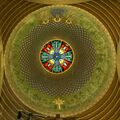Engineering:Cupola

In architecture, a cupola (/ˈk(j)uːpələ/)[1] is a relatively small, most often dome-like, tall structure on top of a building.[2] Often used to provide a lookout or to admit light and air, it usually crowns a larger roof or dome.[3][4]
The word derives, via Italian, from lower Latin cupula (classical Latin cupella), from grc κύπελλον (kúpellon) 'small cup' (Latin cupa), indicating a vault resembling an upside-down cup.[lower-alpha 1]
Background
The cupola evolved during the Renaissance from the older oculus. Being weatherproof, the cupola was better suited to the wetter climates of northern Europe. [citation needed] The chhatri, seen in Indian architecture, fits the definition of a cupola when it is used atop a larger structure.[citation needed]
Cupolas often serve as a belfry, belvedere, vault, or roof lantern above a main roof. In other cases they may crown a spire, tower, or turret.[4] Barns often have cupolas for ventilation.[5][6]
Cupolas can also appear as small buildings in their own right.
The square, dome-like segment of a North American railroad train caboose that contains the second-level or "angel" seats is also called a cupola.[7][8]
Gallery
-
White marble cupolas cap minarets at the Tomb of Jahangir in Lahore, Pakistan .
-
Cupolas on the towers of Montefiascone Cathedral, Italy.
-
Interior of cupola ceiling in the old Synagogue of Győr, Hungary.
-
Ribbed cupola crowns the minaret of the Mosque of Uqba, in Kairouan, Tunisia.
-
Inside of Armenian Orthodox church cupola in Lviv, Ukraine.
-
Cupolas were also used on some old barns for ventilation.
-
View from the interior of the Cupola module on the International Space Station.
-
Trompe-l'œil painting of a cupola in a church in Northern Italy (Brivio).
-
A cupola-style caboose with an "angel seat" above.
On Armoured Vehicles
The term cupola can also refer to the protrusions atop an armoured fighting vehicle due to their distinctive dome-like appearance. They allow crew or personnel to observe, offering very good all round vision,[9] or even field weaponary, without being exposed to incoming fire. Later designs, however, became progressivley flatter and less prominent as technology evolved to allow designers to reduce the profile of their vehicles.

See also
Notes
References
- ↑ "Cupola". Merriam-Webster Dictionary. https://www.merriam-webster.com/dictionary/cupola.
- ↑ "Glossary of Architectural Terms - C". Archiseek: Online Architecture Resources. http://www.archiseek.com/guides/glossary/c.html.
- ↑ "cupola". Boston: Houghton Mifflin Harcourt. 2014. https://www.ahdictionary.com/word/search.html?q=cupola.
- ↑ 4.0 4.1 "Just what is a cupola anyway?". Cupola Consulting. http://www.cupola.com/whatscu1.htm.
- ↑ "What is a cupola and why do barns have them?". 17 March 2014. https://madisonbarns.wordpress.com/2014/03/17/what-is-a-cupola-and-why-do-barns-have-them/.
- ↑ Active Interest Media, Inc. (November 1980). "Old-House Journal". Old House Journal (Active Interest Media, Inc.): 177. ISSN 0094-0178. https://books.google.com/books?id=WgFVx0D9cXYC&pg=PA177.
- ↑ "Railroad Dictionary: A". CSX Transportation. http://www.csx.com/index.cfm/about-csx/company-overview/railroad-dictionary/?i=A.
- ↑ Zabel, Darcy (2005). The (Underground) Railroad in African American Literature. Peter Lang. p. 5. ISBN 9780820468167. https://archive.org/details/undergroundrailr0000zabe.
- ↑ "#15 Turrets: They are the Combat Power of the Tank". http://www.theshermantank.com/tag/all-around-cupola/.









